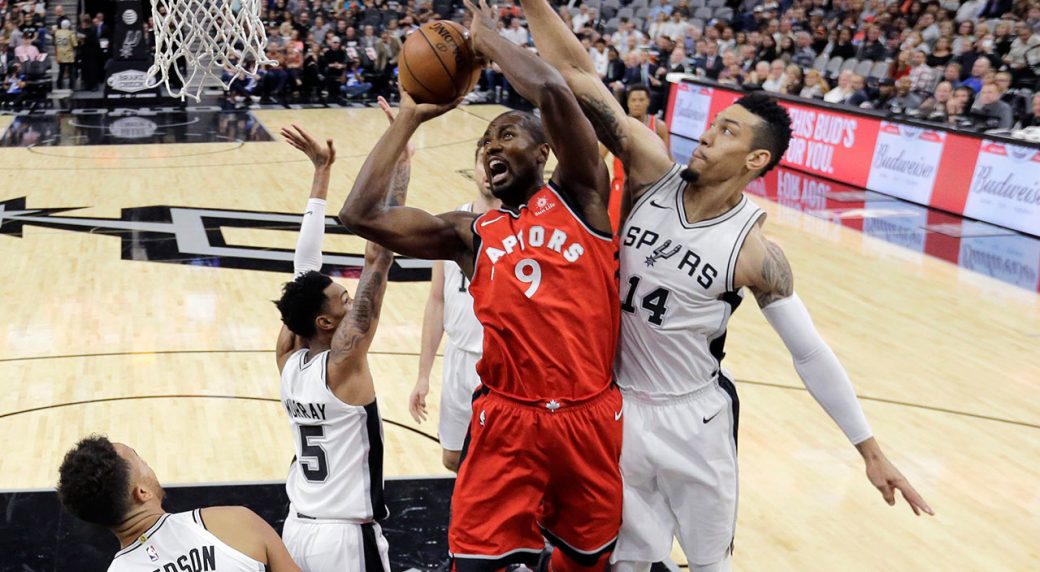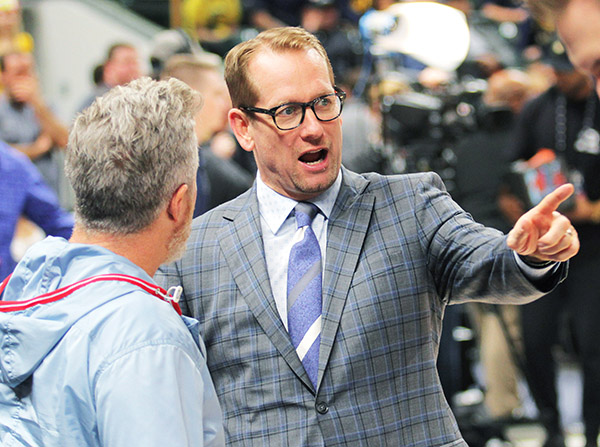As players age out of their natural athleticism, many thrive by playing a position down. Michael Jordan played as a forward for the Wizards, which Kobe Bryant of course mimicked in his late career. Jason Kidd became a shooting guard. The great Boris Diaw entered the league as a point guard and left it as a center. Serge Ibaka looks to be following in the footsteps of a variety of intelligent, decreasingly athletic players before him.
The last we saw Ibaka, he laid an egg, shooting-wise, against the Cleveland Cavaliers in the playoffs. The spacing he provides as a power forward is valuable, sure, but it certainly isn’t above league average for the position. Cleveland was happy to let Ibaka gun away from deep, and he obliged by shooting 30.0 percent from 3 for the series. Despite a full season of success – and most of the playoffs, notching a positive net rating for the entire 2017-18 playoffs – at the power forward position, it seemed all of a sudden as though Ibaka had outgrown the power forward position.
Sure enough, Ibaka has played center almost exclusively so far this preseason. It’s not that Ibaka can’t function as a power forward. He can. The bet is that Ibaka will help the team more in the minutes he plays as a center. So far, Nick Nurse, and the howling chorus of wanna-be coaches (otherwise known as fans) have been right.
On offence, Ibaka’s spacing is invaluable. I wrote a few weeks ago, in a preview of the potential bench lineup, that his shooting would help the team as much or more than Jakob Poeltl’s departed screening.
“Every player on last year’s bench struggled finishing over length except perhaps Poeltl. Without Poeltl’s defender lurking in the paint this year, they will all surely shoot better at the rim. In fact, in the 238 possessions during which Ibaka played center last year, the Raptors shot an absurd 78.8 percent at the rim versus a team-wide 63.2 percent when Poeltl played the same position.”
The difference has been blatant, right from the get-go. Here Fred Van Vleet has a wide-open driving lane because Ibaka demands defensive attention when he’s above the key. This is quite simple, and Ibaka has almost no active part to play in this bucket; however, were Poeltl or Jonas Valanciunas to have been in Ibaka’s place in this situation, Utah’s Alec Burks would already have been stationed at the nail, forcing Van Vleet to give the ball up.
Spacing from a shooting threat is a simpler way to open driving lanes than a good screen. One thing though – Ibaka has been hitting people with his screens! I’ve long raged and ranted about Ibaka’s predilection to brush past his intended target, turning his body to allow the defender to squeeze past, so that Ibaka himself could float above the arc and try to spot up for a jumper. It’s clear that Nurse won’t accept that behavior from Ibaka when he’s the only big on the court. Here Ibaka makes contact twice with pindown screens, opening a modicum of driving space down the center of the court. He eventually short-rolls well, constantly keeping a passing lane open. When he does receive the ball, his immediate decision-making allows an easy short flip shot to fall. This is good center-ing.
When Ibaka plays as a center, his other skills that are only average for a power forward become great for a center. He’s not a fantastic ball-handler or passer for a power forward. As a center, he actually has impressive vision. Here he again rolls slowly to keep the passing lane open, and then immediately fires a pass to the strong corner when he sees a help defender barricading his path to the rim. This is a high level pass that Ibaka didn’t demonstrate consistently last year.
On defence, Ibaka has been something more of a mixed bag, though even his mistakes have had some silver linings. Here Ibaka overcommits to the ball-handler out of the pick-and-roll. He allows the roller to slip behind him. Though a difficult task, Ibaka will need to trust his guard defenders to recover and consistently take away both options in the pick-and-roll.
Slightly later in the game, Ibaka did just that. In this Joe Ingles-Derrick Favors pick-and-roll, Ibaka defends the driver and the roller quite well. He even recovers to help contain Favors on the glass.
Ibaka showed improvement, even within the context of one game. Utah runs a nifty little play that puts opposing centers in a difficult position. With the ball in the corner, Utah’s center screens for the entry-passer to jet into the lane. The natural inclination for the center would be to drop to take away the cut; however, the actual threat is the next screen, as Utah’s center turns and opens a triple for a wing shooting across the top of the arc. The defensive center must tag the original cut for a moment, trust the rotation behind him, and then close on the second screen to take away the shooter. That is difficult, and Ibaka here fails to challenge Utah’s Grayson Allen.
Despite his initial mistake, Ibaka learned quickly. Only a few minutes later, early in the second quarter, Utah ran the same play on the other side of the court. Ibaka tagged the first roller for an instant, rose to challenge the second action, convincing Allen to think he had an open cut to the rim. Ibaka dropped once more to tag the second cut, and then rose again in time to challenge Derrick Favor’s bail-out jumper. Fantastic defence against a play that had just burned him.
That wasn’t the only time Ibaka sniffed out a false action and recovered to challenge the real play. At the end of the first quarter, Ibaka ignored his own man setting a ball screen and correctly defended the real play – a drive from the wing, opened up by the false screen. Ibaka recovered to pin the shot, though it was incorrectly called a goaltend.
Ibaka has been communicating well from the center position. When he anchored a morphing 2-3 zone, Ibaka was great at barking out commands. He actively controls the positioning of Kyle Lowry and then Kawhi Leonard before forcing a turnover from Utah’s Rudy Gobert.
To be clear, Ibaka’s numbers have been putrid thus far this preseason, and he’s made a few bone-headed mistakes. But preseason is not about numbers. Ibaka hasn’t shot the triple well, and his lineups have been outscored massively when he’s on the court. But he’s made the right plays in the right situations, which is really the only thing worth watching for in the preseason. The preseason is really the only time where the eye-test is just way more important than numbers.
Ibaka’s screening and passing look better this preseason. He has shown the ability to quarterback a defence from the center position. Though he will need to get better at navigating false actions, multiple actions, and ball screens, he has shown the aptitude to defend them well. Ibaka may spend a large share of his minutes as the lone big on the floor this year. He’s up to the task.



